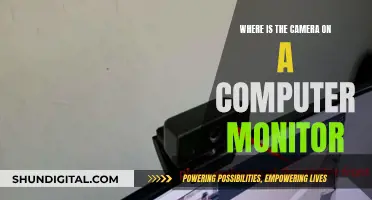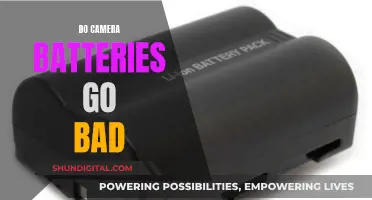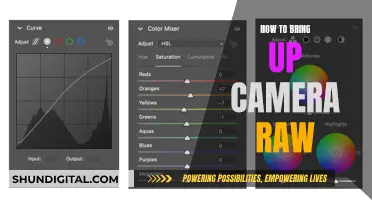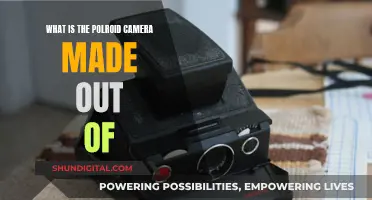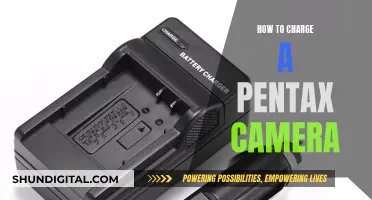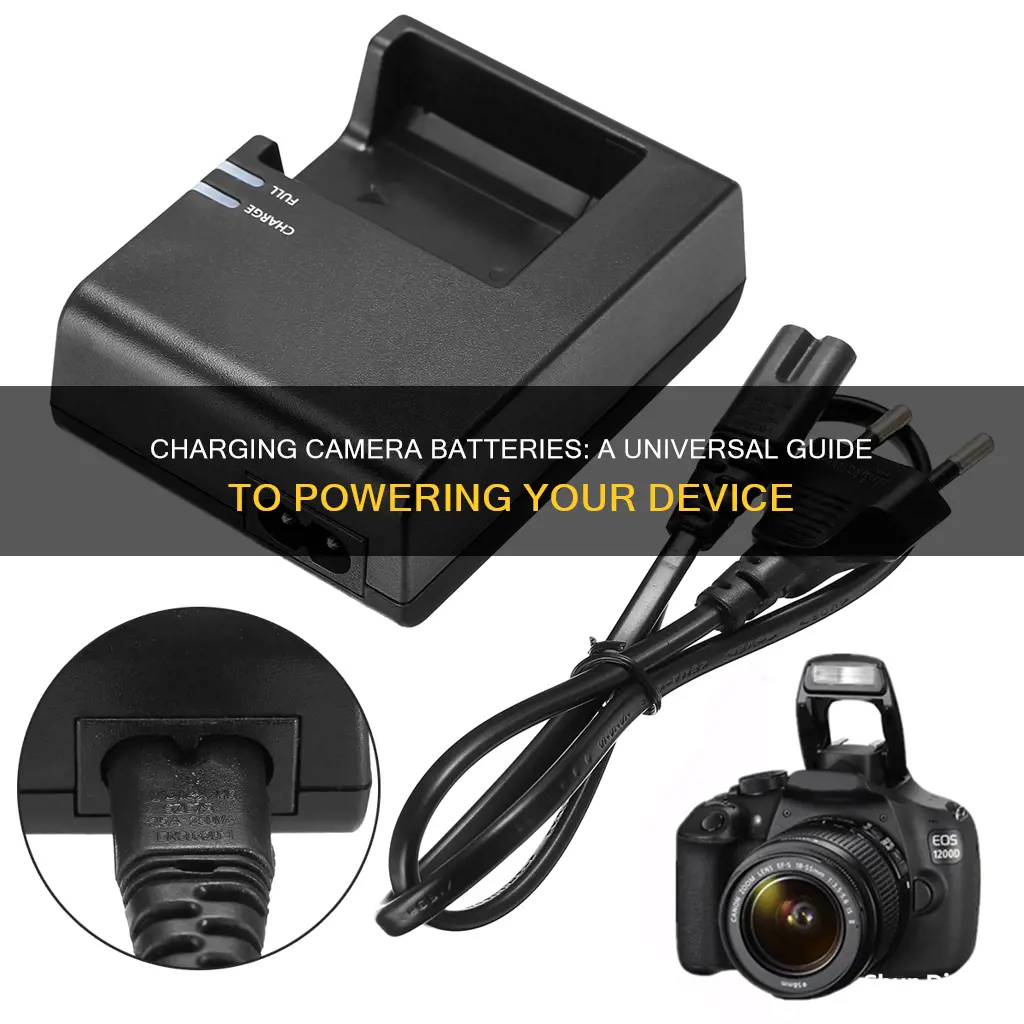
Charging your camera battery can be a straightforward process, but what happens when you're on the go and realise you've forgotten your charger? Luckily, there are alternative ways to charge your camera battery without a charger. You can use a USB cable, a third-party charger or mobile power source, or even charge via a computer or laptop.
For modern digital cameras, direct charging via a USB cable is possible. Simply locate the USB port on your camera, connect the USB cable to your camera and power adapter, computer, or mobile power source, and confirm that the charging indicator lights up.
If you don't have access to a power adapter, you can also charge your camera battery using a computer or laptop. Most computers and laptops have a USB port that can be used for charging. Connect your camera to the USB port and verify that the charging indicator light is on or check the screen to see if it's charging.
However, it's important to note that charging through a computer or low-power USB adapter may be slower, so it's recommended for non-emergency situations. Additionally, always ensure that the voltage and current specifications of any third-party charger match those of your camera battery to avoid damage.
| Characteristics | Values |
|---|---|
| Charging with a power adapter | Connect the camera with the battery inserted to the power adapter using the USB cable. Then, connect the power adapter to the wall outlet. |
| Charging with a computer | Put the battery in the camera, switch off the camera, and make sure it has a memory card installed. Connect the camera to the computer's USB port using the USB cable. |
| Charging with a power bank | Use a compact power bank and PD cable. Attach one end of the USB cord to the camera's input port and the other end to the power bank's output slot. |
| Charging with a car battery | Use small incandescent bulbs such as flashlight bulbs and Christmas tree mini lights as current regulators. |
| Charging with a DC source and resistor | Find a source of DC electricity and use Ohm's law to determine the resistor required to get the right current. |
| Charging with a bench supply | Turn the current and voltage knobs all the way to the left. Turn on the power supply and hook it up to your battery, ensuring correct polarity. Adjust the voltage and current limit knobs to get the desired current. |
What You'll Learn

Charging a camera battery with a USB cable
Steps to Charge a Camera Battery with a USB Cable:
Step 1: Insert the Battery
First, insert the battery into your camera for charging. Ensure the battery is facing the right way and locks into place when inserted. Some cameras may be charged via a built-in USB connector, while others may require an additional USB converter.
Step 2: Connect the Cable
With the camera turned off, open the cover and insert the smaller plug of the USB cable into the camera terminal. Then, connect the larger plug of the cable to your chosen power source. You can use a compact power adapter or a computer to charge your camera battery.
Step 3: Begin Charging
If using a power adapter, simply plug it into a power outlet. If using a computer, ensure it is turned on to initiate charging. The camera's charging indicator light should turn on, or the screen should display that charging has begun.
Step 4: Charging Complete
Once charging is complete, the indicator light will turn off. Be sure to remove the compact power adapter from the power outlet and the interface cable from the camera. It is recommended not to charge your camera battery continuously for more than 24 hours to protect the battery and maintain optimal performance.
Additional Information:
It's worth noting that charging a camera battery via USB may be slower than using a dedicated charger, and it may not be suitable for larger batteries due to limited power output. Additionally, always use a high-quality USB cable to ensure secure and effective charging.
By following these steps, you can conveniently charge your camera battery using a USB cable, making sure your camera is ready for your next photography adventure.
Focus Camera: Tax-Free Shopping?
You may want to see also

Charging a camera battery with a power bank
Step 1: Check Camera Compatibility
Before you begin, ensure that your camera supports USB charging. Some cameras have an in-built USB charging port, which can be used to directly connect the camera to the power bank. However, not all cameras are capable of USB charging with the battery inside the camera.
Step 2: Choose the Right Power Bank
Select a power bank with a capacity higher than your camera's battery. This ensures that the power bank can provide a full charge. Additionally, consider the power bank's shape, size, and weight, especially if you intend to carry it in your pocket or bag.
Step 3: Connect the Camera and Power Bank
Turn off your camera. Connect one end of a USB cable to the camera's input port and the other end to the power bank's output slot. Ensure you use the correct cable, preferably the USB interface cable that came with your camera or one recommended by the manufacturer.
Step 4: Monitor the Charging Process
Check the camera's screen or indicated LEDs to confirm that the battery is charging. The power bank's LED indicator light should also illuminate, signifying that it is providing power.
Step 5: Safe Charging Practices
Always follow the manufacturer's guidelines for charging. Do not overcharge the battery, and avoid leaving the camera unattended while charging. Additionally, ensure that the power bank's output voltage matches the camera battery's requirements to prevent damage.
Bonus Tip: Charging the DSLR Battery Externally
You can also charge the DSLR battery outside the camera if the battery charger has a USB connection. Simply plug the charger into the power bank. However, this method won't work if the charger connects directly to a power outlet.
By following these steps, you can conveniently charge your camera battery using a power bank, ensuring your camera is ready for your next shooting adventure.
Charging Your Camera in Europe: What You Need to Know
You may want to see also

Charging a camera battery through a computer
Step 1: Check Compatibility
Before attempting to charge your camera battery through your computer, it is crucial to consult your camera's manual or the manufacturer's website to ensure that your specific camera model supports this charging method. Some cameras, such as certain Sony models, cannot be charged via a computer's USB port and require the use of the supplied AC adapter or battery charger.
Step 2: Prepare the Camera
Once you've confirmed that your camera can be charged via a computer, make sure to turn off your camera completely. Some camera models may also require a memory card to be inserted for charging to work. Refer to your camera's manual to understand any specific requirements.
Step 3: Connect to Computer
Take the USB cable that came with your camera and connect it to your camera at one end and an available USB port on your computer at the other end. Ensure that the connections are secure.
Step 4: Monitor the Charging Process
When the camera is connected to the computer, a pop-up may appear on your computer screen. Follow any instructions provided to authorise the charging process. In some cases, a light may illuminate at the connection site, indicating that electricity is being delivered to the camera.
Step 5: Allow Sufficient Charging Time
Keep your camera connected to the computer until it is fully charged. Depending on your camera's battery capacity, this process may take around two to three hours. Once the camera is fully charged, the light at the connection site will turn off.
Important Considerations:
- Always use the USB cable provided by the camera manufacturer. Using incompatible or non-genuine cables may damage your camera or affect its performance.
- Be mindful of the power requirements of your camera. Some cameras, especially DSLRs and mirrorless cameras, have higher power requirements and may not be suitable for charging via a computer.
- Keep your camera turned off during the charging process. Charging may not work if the camera is left on.
Charging Your Polaroid: A Step-by-Step Guide to Powering Up
You may want to see also

Charging a camera battery with a third-party charger
If your camera's original charger is not available, you can use a third-party charger or mobile power supply. These devices usually support a variety of battery models with multiple ports. However, it is important to exercise caution when using third-party chargers. Here are some detailed instructions on how to charge a camera battery with a third-party charger:
First, confirm the compatibility of the third-party charger or mobile power source to ensure that it supports your camera battery type. Check the voltage and current specifications of the charger to make sure they match those of your camera battery. Using a charger with incompatible voltage or current specifications may damage your battery or camera.
Once you've confirmed compatibility, remove the camera battery from the camera and insert it into the third-party charger. Then, connect the power supply to the charger. Confirm that the charging indicator on the charger is on.
It is important to note that frequent use of third-party charging methods may affect battery life. Therefore, it is recommended to use the original charger whenever possible to prolong battery life. Additionally, choose reliable third-party chargers and avoid using inferior products that may cause damage to your camera and battery.
After the battery is fully charged, remove it from the third-party charger and reinsert it into your camera. Now your camera battery is fully charged and ready to use!
Charging the Panasonic Leica Dicomar Camera: A Step-by-Step Guide
You may want to see also

Charging a camera battery with a car battery
Another option is to buy a camera charger with a car adapter. These can be found on Amazon for around $10.
If you want an official Canon accessory, you can use the CB-570 Car Battery Cable, which works with the CG-570 Battery Charger.
It is important to note that you should not leave your camera battery charging unattended and you should not attempt to fully charge it. Overcharging can lead to potential safety hazards, such as the battery catching on fire. Additionally, car batteries can produce a mixture of oxygen and hydrogen, which can be ignited by a spark, leading to an explosion. Therefore, it is recommended to only trickle charge your camera battery to a level that is sufficient for your needs, rather than attempting to fully charge it.
GoPro Charging Time: How Long Until Your Camera's Ready?
You may want to see also
Frequently asked questions
You can charge your camera battery without a charger by using a USB cable, a power bank, or a computer.
First, turn off your camera and insert the battery. Then, attach the USB cable to the camera or the external battery pack. Finally, attach the USB wall adapter to the USB cord and plug it into the wall.
Yes, you can charge your camera battery with a power bank. Ensure that the power bank has enough energy to charge your camera, has a compatible interface and output, and can deliver the appropriate voltage.
Most computers and laptops have a USB port that can be used to charge your camera battery. Simply connect your camera to the USB port on your computer or laptop using a USB cable.
Yes, it is important to ensure compatibility between your charging method and your camera battery to avoid damage. Do not expose the camera and battery to high temperatures or humidity while charging, and stop charging immediately if you notice any abnormalities.


